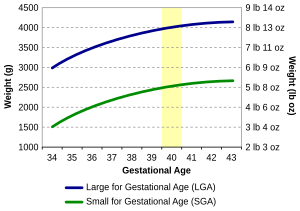Gestational age
Gestational age (or menstrual age) is a measure of the age of a pregnancy where the origin from woman's last normal menstrual period (LMP), or the corresponding age as estimated by other methods. Such methods include adding 14 days to a known duration since fertilization (as is possible in in vitro fertilization), or by obstetric ultrasonography. The popularity of using such a definition of gestational age is that menstrual periods are essentially always noticed, while there is usually a lack of a convenient way to discern when fertilization occurred.
The initiation of pregnancy for the calculation of gestational age can be different from definitions of initiation of pregnancy in context of the abortion debate or beginning of human personhood.
According to American Congress of Obstetricians and Gynecologists, the main methods to calculate gestational age are:
Gestational age can also be estimated by calculating days from ovulation if it was estimated from related signs or ovulation tests, and adding 14 days by convention.
A more complete listing of methods is given in following table:
As a general rule, the official gestational age should be based on the actual beginning of the last menstrual period, unless any of the above methods gives an estimated date that differs more than the variability for the method, in which case the difference cannot probably be explained by that variability alone. For example, if there is a gestational age based on the beginning of the last menstrual period of 9.0 weeks, and a first-trimester obstetric ultrasonography gives an estimated gestational age of 10.0 weeks (with a 2 SD variability of ±8% of the estimate thereby giving a variability of ±0.8 weeks), the difference of 1.0 weeks between the tests is larger than the 2 SD variability of the ultrasonography estimate, indicating that the gestational age estimated by ultrasonography should be used as the official gestational age.
...
Wikipedia

